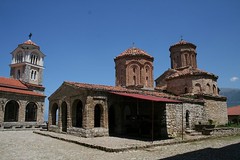
Leaving Ohrid. On the way to Prilep we stopped at the Monastery of St. Naum by the Ohrid lake, close to Albanian border and right next to a large spring of crystal clear water. St. Naum and St. Kliment travelled with Cyril and Metodus all the way to Great Moravia, from were they eventually returned and founded the Ohrid university. In the monastery there is a church with the remains of St. Naum from the 10th century. The chapel with the tomb of St. Naum is covered inside with frescoes depicting the life of the saint, including one scene where Naum is being chased by the heretical Bogomils. By the entrance to the church there are two marble pillars which have grafitti-like slavonic cross engravings in several places reminiscent of glagolic signs. Almost all churches from this period have a special intimate atmosphere of a spiritual encounter, perhaps because the saints who are crowding alongside you on the walls, are lifesize and within reach.
In the ticket office we met our old friend Danko, who Standa, Tomáš and Martin interviewed when they were here last year in the fall. He happily pulled out a bottle of rakija and shot glasses from under the counter, and this church foreroom turned, for a few minutes, into a bar.
Danko chose as his favorite the letter Д as dům (house), duša (soul), dobro (goodness), da (yes) and Danko, his name. His second letter was T, because there is a table in the house, or a sacrificial altar. He chose the glagolic letter ŠČ for St. Naum, as „ščot“ (the sum) of D and T.
We climbed up over the Galičica mountains on a small road, and saw beautiful views both of the Ohrid as well as the neighboring Prespanske lake. On the way to Prilep we passed by Bitola, which has both the remains of Roman settlement and the messy but pictoresque gypsy quarters.
Vladimir’s family welcomed us in Prilep. His father took us to the village of Varosh, on the outskirts of Prilep. Above was the towering rock with the fortress of King Marko, and right below the rock but high above the village was a monastery of St. Archangel Michael. We met a young monk at the monastery. He told us how originally, in the 9th century, this place was a hermitage, and the monk’s teachings were so attractive that eventually he gathered followers who settled in the caves around, and founded a monastery. The door to the church was guarded with the fresco figures of king Marko and his father. Marko was depicted in white dress to mark the mourning after his beloved father’s death at the time of building this church. Inside were lines of saints, most of them doctors, such as St. Cosmas and Damian. The monk showed us a glagolic text carved into the marble pillar at the church entrance. He mentioned that he was surprised that Kliment changed the glagolic script into cyrilic, because the glagolic was developed as a divine act. By changing it, Kliment would be committing a sin against his teacher and God, so there must have been political pressures for replacing the glagolic with a new script. Kliment would most probably not have done this on his own.
We descended to the village of Varosh, which was the oldest serttlement in the area. As the city grew and other settlements were being „glued on“, the city came to be called Prilep (glueing), at least according to Vladimir. There were originally 70 churches in Varosh, one for each house. Several churches are still preserved, almost right at the houses‘ backyards. They are from the 13th century and several of them still have wonderfully preserved frescoes. You can see how recycling worked at that time—each of the churches has carved marble stones build into its walls, still with the Greek inscriptions and reliefs.
After a great banquet that Vlado’s mom prepared for us, we still went to explore the town center and ended up in the ВИРУС bar. The last item on the day’s program was a showing of a film called The Secret Book about the legendary sacred book of the medieval Bogomils. Part of the book took place in visions and dreaming, and since we watched from the beds, some of us naturally transitioned from the dreams in the film into their own.
No comments:
Post a Comment